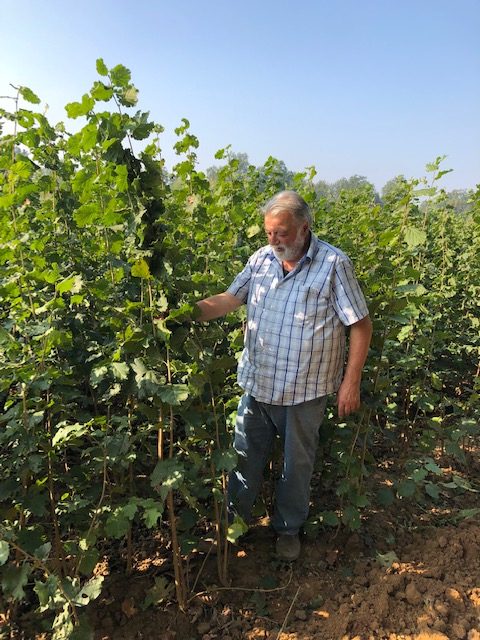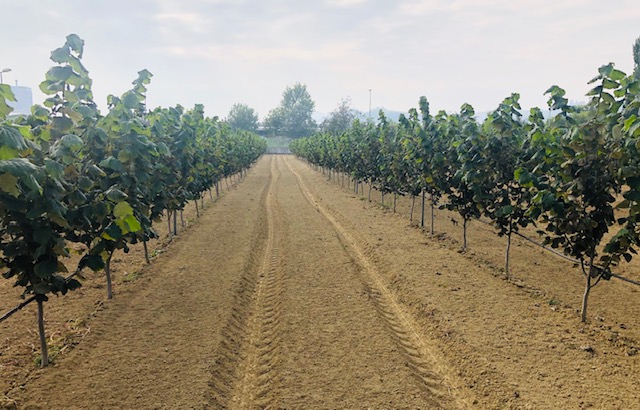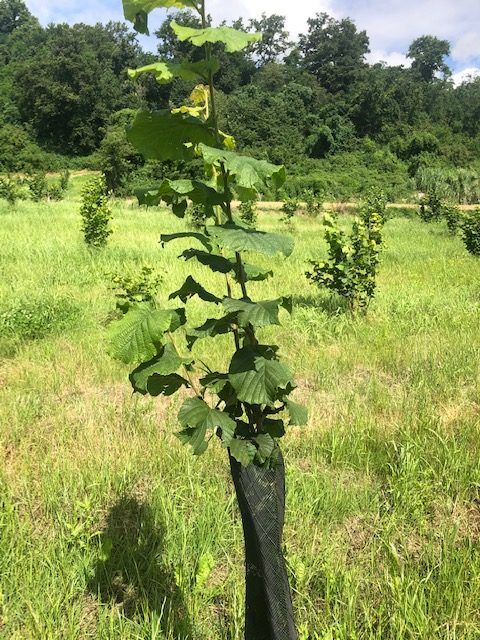
The Tonda Gentile variety (syn. of Tonda Gentile Trilobata or Tonda Gentile delle Langhe) has natural origins in Piedmont, in the Langa area.
The plant grows spontaneously in broadleaf forests up to 1000 m above sea level as a wild species, reproducing naturally by seed, thus losing the characteristics of the independently selected variety, probably by gem mutation.
To obtain income yields, it must be cultivated like a normal fruit plant, in fertile and suitably tilled soils, in order to avoid competition from grass and to break the capillarity of the soil, which causes excessive soil evaporation.
Needs drained soil: areas with waterlogging should be avoided at all costs. Suffers from excessive soil compaction which can cause root rot and asphyxia.
Adequate training and production pruning avoid alternation phenomena to which the plant spontaneously tends, as the differentiation of the fruit buds occurs in August and if the plant is under stress following a strong production, it tends to form wood buds.

Multiplication is a very complex practice as it cannot be done by seed but by using a portion of the mother plant; it does not root by cuttings and the practice of grafting attempted in recent years presents considerable difficulties.
In the past, the hazelnut tree was propagated by removing suckers from mother plants. this practice must be abandoned as viruses and fungi could be transmitted and there is no certainty as to the DNA of origin. the most correct technique used today is to graft rootstock. mother plants are planted, certified with traceability of origin, on which virological analyses are carried out periodically by the Piedmont Region’s Phytopathological Service.
After three years, the stumps are pruned to zero so as to stimulate a strong emission of suckers. These, in June, are ringed at collar level with a metal ring and covered with soil. The ringing stimulates the emission of roots above it. If the root system is sufficiently developed, the seedling can be planted directly, otherwise it will have to spend another year in the nursery.
IHAZELNUT PLANTING – CORRECT PLANTING
How should a hazelnut plantation be correctly executed from a technical point of view?
The correct planting of a hazelnut grove must take into account the particular characteristics of the plant:
- Natural tendency for the root system to develop horizontally on the surface within a depth of 30 cm;
- Suffers from root asphyxiation, needs aerated and drained soil;
- Has a very fine root capillitium, sensitive to the salinity of chemical fertilisers, is easily altered if exposed to sun or wind at the time of planting.
Consequently, it is important to carry out deep tilling before planting to allow water drainage and aerate the soil.
Deep ripping (50-60 cm) is ideal, to be preferred when possible to ploughing, which would send the fertile and vital layer on the surface to the depth.
Should a chemical-physical analysis be carried out before planting a hazelnut grove?
It is important to check the suitability of the soil before planting, thanks to a physico-chemical analysis. for hazelnut trees, the following parameters should be asked: grain size analysis, Ph (soil acidity), presence of active lime (must be less than 8%), organic substance, CAC (cation exchange capacity) and nutrients to assess any nutritional deficiencies or imbalances.
How should a soil for a hazelnut plantation be fertilised?

When possible, it is always useful to add organic matter, which is often lacking in many soils, with mature manure to be buried before planting. Excellent results are obtained with the practice of green manure with leguminous and brassicaceous plants, which can be carried out before planting or even in the first few years by sowing in alternate rows. Burying the plant mass produced brings organic substance that improves the physical structure of the soil, making it less asphyctic, triggering processes that improve soil vitality. In addition to the supply of nitrogen produced by nitrogen-fixing micro-organisms produced by the leguminous plants, the supply of phosphorous, a fundamental element for root development, is important (approximately 120 units per hectare equivalent to 6 quintals per hectare of mineral superphosphate 18-20).
This fertiliser has an acidifying action on the soil, releasing elements made unavailable by the presence of active lime. Once the soil has been prepared, proceed with a final refinement to be carried out with a rotary harrow (rotograss) or tiller. Tracing will then be possible.
Correct planting of a hazelnut grove is fundamental to obtain a vigorous plant from the first years with consequent better resistance to disease and with the prospect of earlier entry into production.
The hole must be made taking care not to compact the soil to a depth of no more than 25-30 cm, depending on the type of plants to be planted. The necessary size will be assessed.
One-year-old plants or stump margots need a 25 cm hole, while 2 or 3-year-old plants with 2 or 3-year-old roots need a 40 cm hole.
The holes can be drilled manually or with a mini-excavator. The use of the auger can only be carried out on particularly dry soil to avoid creating a kind of ‘glass’ that would process the water causing asphyxia. It is a good idea to widen the root to encourage its development in accordance with its characteristics, unlike fruit plants that have tap roots.

It is essential to create an ideal chemical and physical environment in the root zone for the root to develop rapidly. In contact with the root place 3 to 5 litres of compost/universal potting soil or acid peat if planting in alkaline soils.
On the peat-soil put 500 g of Leonardite, a substance of natural origin rich in humic and fulvic acids, a bio-activator of soil fertility, thus creating an optimal physio-nutritional niche near the root system with an increase in the soil’s capacity to retain nutrients and water.
It is then covered with soil, taking care not to compact it, especially if the soil is not particularly dry.
On the surface in a diameter of approximately 50 cm around the plant, apply 500 g of Prodigy Plus, a natural organic fertiliser of plant origin which, in addition to having slow-release nutrients, is a powerful activator of soil micro-organisms and creates optimal conditions for the development of natural symbiotic mycorrhizae, which improve the absorption capacity of the roots.
What should the ideal hazelnut plant look like?

The seedlings must have a developed but young and well fascicled root system with the presence of important root capillitium. The stem must always be 1 year old, even though the plant may have a 2 or 3 year old root system, so that after transplanting it can vitalise vigorous dormant buds that will form the new branches of the plant; aged stems have little vitality and may be subject to attack by wood pests. It is important that the root has been inoculated with natural mycorrhizae, which have settled on the root and will increase its absorption capacity. A type of plant that gives better results is stump layering if it is produced using the right method with a young, well-developed root system, or plants with 2 or 3-year-old roots (extra R3F1 plant, obtained using a special cultural technique) and 1-year-old stems that have received special treatment.
https://www.traversalorenzo.com/wp-content/uploads/2020/02/PIANTA-DI-NOCCIOLO-EXTRA-R3F1.pdf
After planting, the plant should be pruned to 60 cm in order to allow it to emit vigorous shoots that will become constituent branches of the plant, forming a tree or bushy pot plant.

In areas with the presence of lagomorphs (hare or mini hare) or roe deer, I recommend placing special netted supports to protect the plant in the first years.
This planting protocol, followed by careful processing in the first few years, is more laborious and costly than certain methods widely used today in large plantations, such as machine-planting, but it will result in a more homogenous, healthier hazelnut grove that will certainly anticipate the start of production.
An extra 1 kg per plant produced in the 4th to 5th year will more than compensate for the higher expenses incurred.

Lorenzo Traversa
+39 3487128556


